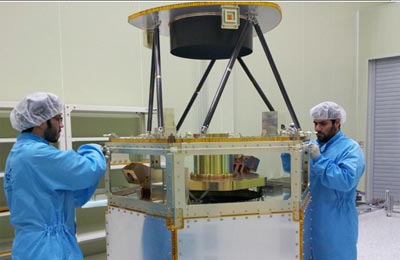
DubaiSat-2 ‘ready for operation’
Dubai, August 16, 2012
UAE’s state-owned Emirates Institution for Advanced Science & Technology (EIAST) has announced that the DubaiSat-2 project has successfully completed software testing and is now ready for operation.
The tests were part of a process known as Flight Model (FM) testing. In the aerospace industry, three-stage testing is the norm for advanced systems. In the first stage, a fully functional Engineering Model (EM) of the satellite and its payload are constructed.
Using the EM, engineers put all of the subsystems and their components through their paces, often surpassing normal performance requirements in order to find potential faults. Based on the results of the EM stage, changes are made and the project moves to the next step in the process, testing the Qualification Model or QM.
“I am delighted that the EIAST engineers have successfully brought this important project closer to reality. Through their dedication and expertise, our team of highly skilled UAE engineers has contributed to EIAST’s aim, which is to position Dubai and the UAE as a science and technology development hub among advanced nations,” said Ahmad Al Mansoori, director general of EIAST.
The EM and QM stages were completed in February. Checking out the satellite in the FM stage takes time because of the focus on onboard software and the mission control software. The simulations are done in real time, giving EIAST a data stream that will simulate what occurs when the satellite is in orbit.
“Having gone through the software testing and its successful completion, DubaiSat-2 has achieved a major milestone in its journey towards launch later this year. A number of tests have so far been carried out as part of this project,” said Salem Al Marri, project manager of DubaiSat-2 and head of Marketing and International Affairs Department, EIAST.
“These tests are designed to put the satellite through the same or similar conditions that it will face on its journey to space.”
“The DubaiSat-2 project has achieved significant success due to the committed participation of UAE engineers in the project,” said Amer Al Sayegh, director of the Space Systems Development Department in Korea.
“Our engineers are involved in developing solutions, techniques and advanced research, showcasing our ability to embrace cutting edge scientific research and development,” added Al Sayegh.
The satellite will orbit 600 km above the earth’s surface compared to the 690 km orbit of DubaiSat-1.
The orbit has also been changed from an ascending orbit (South to North) to a descending orbit (North to South), which will allow both satellites to work well in constellation as well as give better coverage of the UAE area.
Among other significant improvements, the UAE team along with their South Korean Partners (Satrec Initiative) has designed the satellite to produce higher quality images at 1 meter resolution which can serve various applications including environmental projects, urban planning, infrastructure, telecommunications and electricity projects.
The DubaiSat-2 project is a joint development programme between EIAST and Satrec Initiative of South Korea, in which 16 UAE engineers have been working on the design, development, testing and manufacturing of the satellite.
The participation of the UAE engineers, who are currently working in South Korea, has increased by 100 per cent from the DubaiSat-1 project and it is hoped that this will take EIAST to the next level in satellite development. – TradeArabia News Service







